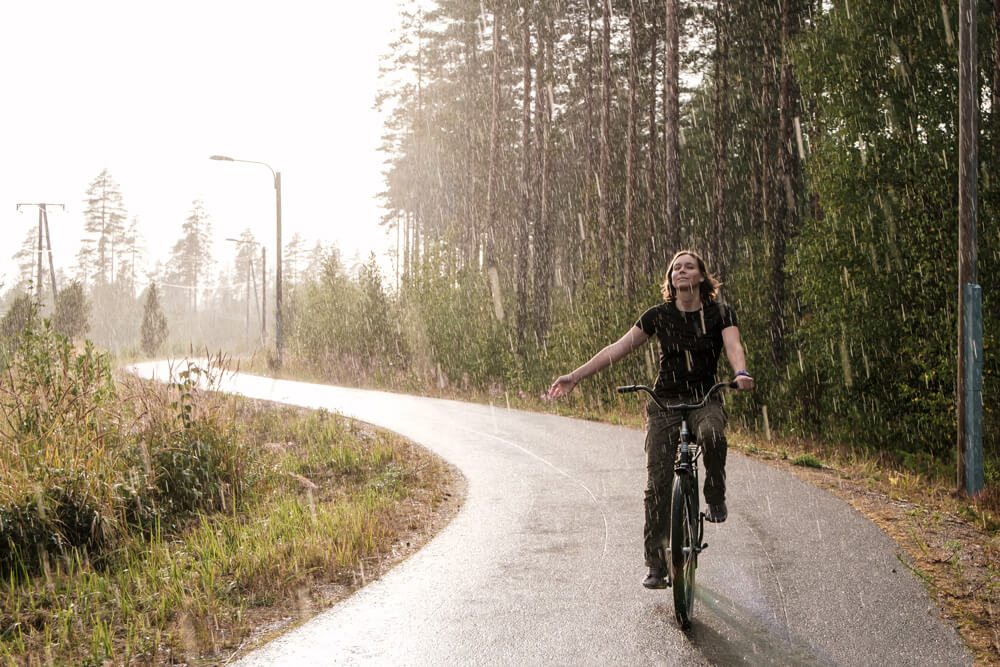
Equip your bike
Going out for a bike ride in the rain does require a bit more setup for your bike to make your ride as smooth and as safe as possible. Before we get into how to keep yourself dry, let’s talk about how to make your bike as prepared as possible with the right gear for biking in the rain. (And don’t worry, you won’t need to invest in tons of new gear!)Use Fenders
Fenders—thin pieces of plastic or metal that attach to your bike’s front fork and rear triangle or seat post in order to block water splashing up from the road—are incredibly useful for rainy rides. A rear fender keeps your bum from getting soaked or mud-splattered, while a front fender may help keep spray out of your eyes. If you ride in the rain often—i.e. you have a commute to the office that you do daily and are often caught in rainstorms—then you may want to install more permanent fenders on your commuter bike or ebike. But if you’re riding a more performance-oriented bike, then you likely don’t want fenders on it all the time. If that’s the case, there are great options for easy clip on fenders for the front and rear wheels. For days when the rain isn’t too bad, just a rear fender will be plenty to keep you a bit drier and happier. Many people choose to skip the front fender.Use Cycling Lights
Even if it’s not dark out, using a front and rear light on rainy days is a must. This is because drivers aren’t as aware of cyclists on rainy days because they don’t expect anyone to be riding in bad weather. They also may have worse vision while driving in a storm. Lights make you more visible, which in turn keeps you much safer. A good set of rechargeable lights, with a front light that can put out 1000 lumens and a rear light that can flash red (50 lumens is fine in the rear) is ideal.Install Wider Tires
The wider your tires are, the more contact you have with the road as you ride, and the more stable you’ll be as a result. We’re not suggesting that you change tires before every rainy ride, but if you’re in a rainy month (like March and April, for many cyclists!), then using wider tires may provide a bit more stability and traction control on slippery days.Reduce Tire Pressure
Whether you swap to wider tires or not, dropping your tire pressure by 5 to 10 PSI on the road, 3-5 PSI on the mountain bike or gravel bike can also help add traction and stability. Dropping tire pressure means that more rubber from your tire will be connecting with the ground. (Confused? Picture pressing a balloon down on a table—it spreads out, just like a tire does as it presses into the ground. The less air, the more it spread.) Don’t take this to an extreme: Only let a tiny amount of air out at a time. A tire that’s nearly flat will be even less stable than one that’s fully inflated!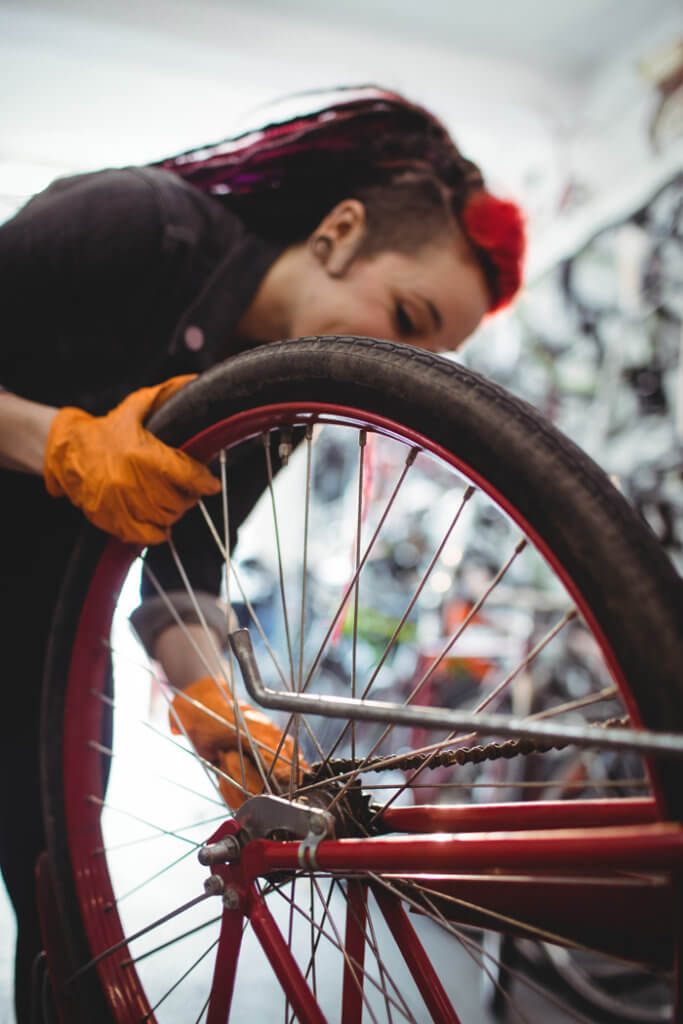
Weatherproof your Bike
Your bike takes a beating anytime you ride in the rain. While there’s no easy way to waterproof your bike, adding fenders will help keep your cockpit (the handlebars and shifters) from accumulating grime from the road, and your saddle will stay cleaner and drier thanks to rear fenders. But the rest of your bike will get soaked and grimy. That means post-ride, you need to take care of your bike. If it’s covered in mud or grime, at minimum give it a quick rinse with warm water. You may need to use a grease-cutting dish soap to get oil from the road off of the bottom of your frame. Make sure you dry it off, especially areas around shifters, the cranks, the bottom bracket, and the brakes. Ideally, you should also give your chain a quick wipedown or complete wash and re-lube, since the chain is where most of the grime sticks around, and that can eventually wreck a chain, or at minimum, lead to an annoyingly squeaky ride.
Equip yourself
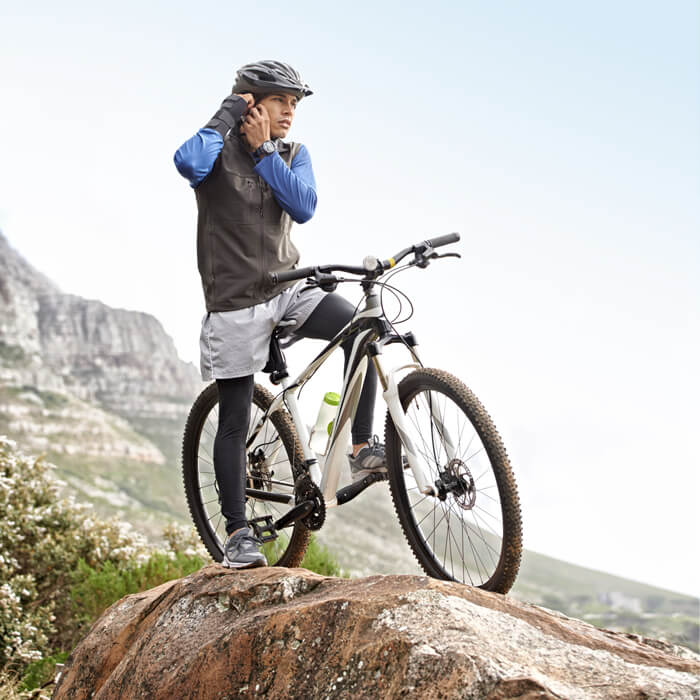
Your bike is under control, but what are you supposed to wear for a bike ride in rain? Fortunately, you don’t need to invest in a ton of extra wet weather gear for cycling, though there are a few pieces of wet weather cycling gear that can make cycling in bad weather much more pleasant.
Wear a waterproof jacket
When riding a bike in the rain, the most obvious piece of useful gear is a rain jacket. Now, you can wear your normal raincoat, obviously, but a cycling-specific raincoat will fit you better and flap less while you pedal. They’re more form-fitting, and are ideal for road riding and mountain biking, though there are also commuter options with great details like reflective accents and pockets for your phone that can be incredibly useful. Cycling raincoats also tend to have dropped backs, in order to keep your bum better protected. (Need a cycling raincoat? Bikerumor has a great roundup of some good options here.)
Wear a cycling cap
You may not realize, but cycling caps (the thin ones with short brims) are actually designed to be worn under helmets. And they can make a huge difference in how easy it is to see the road in front of you on a rainy day, while also keeping your head a bit drier. Make sure you use a cycling cap rather than a baseball cap, which won’t fit safely under a helmet. But the brim of a cycling cap will give you just enough protection that water won’t be streaming down your face.Wear glasses or goggles
A bike ride in the rain can be scary when visibility gets tough, and if you’re riding and dealing with a lot of rain hitting you in the face alongside of mud and road grime splashing up into your face, riding your bike in the rain can get scary in a hurry. Wearing cycling glasses (or in really intense storms, goggles) can save your eyes from splashes and make it easier to watch the road. If your glasses start to fog, try this (kind of gross) triathlete trick: lick them. Sometimes, saliva strangely enough can help keep fog at bay. (There are also anti-fog sprays you can try if that’s too gross!)Wear waterproof gloves and socks
In chillier rainy weather, keeping hands and feet as dry as possible is a huge part of ensuring that they stay warm. Because of this, using waterproof gloves along with waterproof socks or water-resistant cycling overshoes or over-socks can make a huge difference to your in-ride comfort. If you don’t want to invest in a pair of pricey waterproof gloves, try this trick: Just stick a pair of latex gloves under your regular winter cycling gloves to add a waterproof layer! It won’t be as good, since your hands may get sweaty, but it’s a great trick to try in a pinch.Prepare for Dangers
The most important thing to remember about how to ride a bike in the rain is that you need to be paying closer attention to your surroundings than you would on a dry ride. Cycling in wet weather doesn’t need to be scary, but it does mean keeping your head up and staying focused.Avoid Riding Through Puddles
Riding through puddles may give you a childlike sense of joy, but they can be tricky. If you can’t see what’s at the bottom of a puddle, don’t ride through it. It could be much deeper than you expect, or it could contain a nasty surprise, like a piece of sharp metal or a nail. And if it is deeper than you expect, you may get partway through it and stall out, requiring you to put a foot down into the murky water.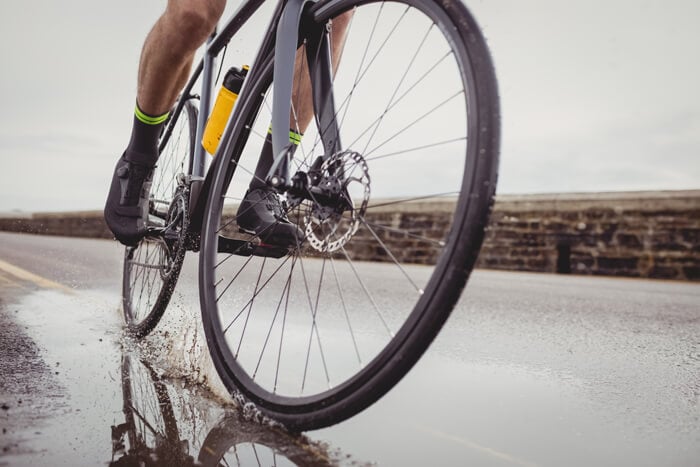
Look Out for Slippery Obstacles on the Road
Things like branches, roots, rocks, and oil slicks become much more treacherous in wet conditions as things get more slippery. But you need to be constantly scanning around you as well as in front of you: Be very aware of traffic coming behind you if you go wide around a wet branch in the road. It’s rarely worth avoiding an obstacle at the expense of putting yourself directly into a car’s path. If you do find yourself in a slippery situation and feel like you’re losing control of the bike, resist the urge to slam on the brakes, since that can make the situation worse (similar to a car that’s hydroplaning). Rather, gently apply pressure to the brakes, and aim for the shoulder of the road (or the softest area you can see) as you try to slow down. Don’t panic.Lightning
It might sound obvious, but at the first sign of thunder and lightning, try to get off the road and seek shelter. Riding a road bike in the rain on open roads can be especially dangerous during lighting storms, so try to get off the road and into somewhere that provides a shelter. If you can’t immediately duck into a coffee shop or bus station, at bare minimum, you should be calling someone for a ride.Defend yourself from unexpected
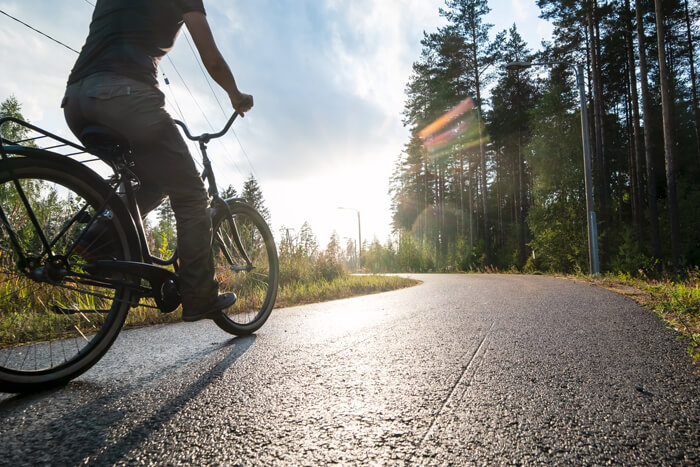
Watch traffic. Riding a road bike in the rain? Remember that if you’re struggling to see in front of you, so are drivers—and arguably having a tougher time since they’re traveling at higher speeds. While obviously, we hope drivers are responsible and focused, it’s important to stay on high alert as a cyclist out in the rain.
Expect the unexpected. Rainy roads can hide things like potholes, nails, or other fun bike-breaking flat-producing obstacles, so make sure that before you leave the house, you have all of the essentials. This means having a couple of spare tubes, a flat patching kit in the event of multiple flats, a set of tire levers, a mini-pump and some CO2 cartridges and the adapter, and a good cycling multitool. And yes, we said a mini-pump AND Co2 cartridges: It’s tempting to just bring the CO2s since they inflate a tire in seconds, but a mini-pump as backup is critical on rainy rides where multiple flats are possible, and where you might be in a slippery situation where you accidentally waste a cartridge.
Add buffer time. Commuting to work in the rain? If you’re riding to work in the rain, assume that it will take a few minutes longer than normal to get there so you can pedal comfortably and not feel rushed. You’ll also need a few extra minutes to dry you and your bike off when you get there, so plan for that as well!
